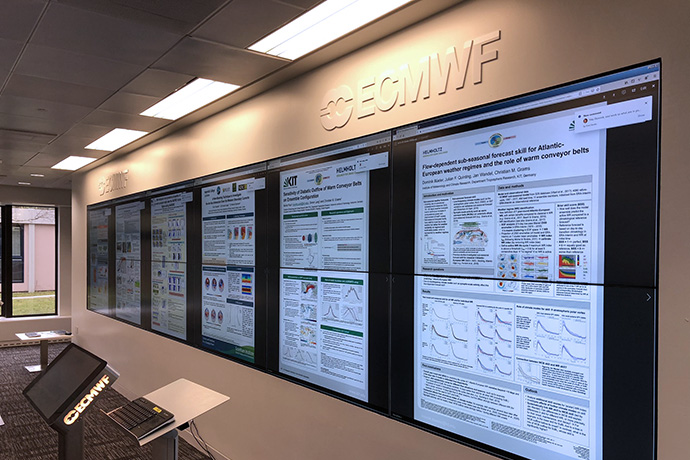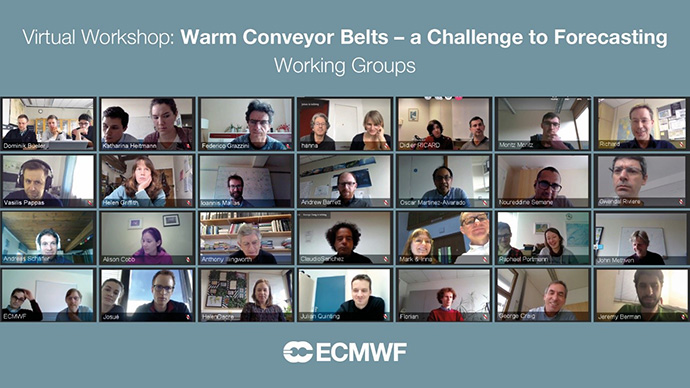

ECMWF Director of Forecasts Florian Pappenberger (left) opened the workshop.
ECMWF brought together over 100 experts in a virtual workshop from 10 to 12 March 2020 to discuss how the latest research on a type of air flow known as warm conveyor belts can help to improve weather forecasts.
A warm conveyor belt (WCB) is an ascending, poleward-moving warm moist airstream in the warm sector of extratropical cyclones. WCBs can have major repercussions on downstream weather but their evolution is often associated with great uncertainty.
“The focus of the workshop was on how our knowledge of WCBs can be extended and used to inform improvements in operational ensemble forecasting,” says Mark Rodwell, one of the organisers.
In response to the COVID-19 pandemic, the workshop was turned into a virtual event and opened up to a wider audience.

A look behind the scenes of the virtual workshop on warm conveyor belts.
Key questions
Questions addressed in the 31 talks and four working group sessions covered aspects such as predictability, observations, models and impacts.
Predictability is an issue because WCBs are associated with great atmospheric instability. This leads to a rapid growth in forecast uncertainty. It is therefore important to identify the key aspects of WCBs which lead to such uncertainty.
Another topic was how well we can estimate the features of WCBs at the start of weather forecasts and whether new observation sources would help.
The talks also addressed the question of how well models represent the complex physical processes in WCBs and what aspects deserve particular attention.
In terms of impacts, the workshop looked into the role WCBs play in weather extremes, regime transitions, and global climate.

Registered participants were able to take part in virtual poster sessions.
Outcomes
Workshop outcomes include plans to make better use of observational campaign data on WCBs to assess ECMWF’s operational data assimilation system. Conversely, insights gained from data assimilation could be used to inform where campaigns could make useful observations.
A topic for further study is the influence of model resolution and of the representation of convection and turbulence on downstream developments.
It would also be useful to investigate key moisture sources for WCBs and the regions of strong water vapour flux that trail behind WCBs, called atmospheric rivers. How well are these sources observed, and how well do models represent the key physical processes?
Future studies should also probe the predictability barrier for WCBs in the extended range. What are the relative contributions to that barrier from inherent uncertainty growth on the one hand and modelling deficiencies on the other? The answer will shed light on what is ultimately possible in extended-range predictions of, for example, blocking conditions and heatwaves.

Registered participants took part in working group sessions via video link.
ECMWF’s first virtual workshop
The warm conveyor belt workshop was the first fully virtual workshop ever organised by ECMWF: all external speakers and participants took part remotely using livestreaming and video conferencing tools.
The decision to make the workshop a virtual one was taken less than two weeks before the start to protect ECMWF staff and visitors from the growing COVID-19 pandemic.
The aim was to replicate the usual elements of a physical workshop as far as possible while fully exploiting the additional facilities provided by the virtual format.
From a central web page, participants could move between workshop talks and poster and breakout sessions. Registered participants received invitations to all breakout groups and selected the one they preferred.
“Instead of a workshop dinner, we trialled a ‘night owl’ poster and discussion session, which was at a suitable time for those in North America to participate,” Mark says.
The virtual format made it possible for up to 150 people to participate, either fully or as observers. “That’s nearly three times as many as had been planned for the physical event,” says Mark. “This workshop became the testbed for possible future virtual events, and judging by the feedback from participants, it was a great success.”

Feedback from participants was very positive.
Further information
All presentations, recordings and posters are available on the workshop page on the ECMWF website.
An ECMWF Newsletter article on ‘Why warm conveyor belts matter in NWP’ was published in January 2018.
